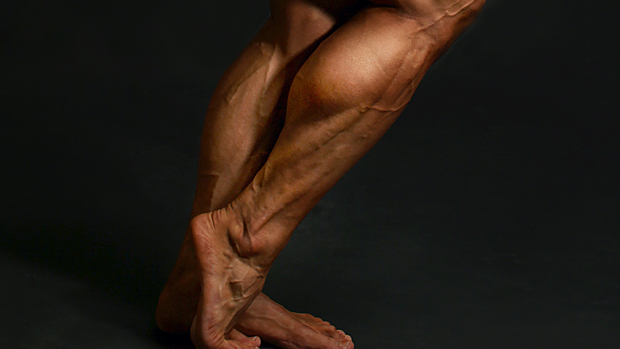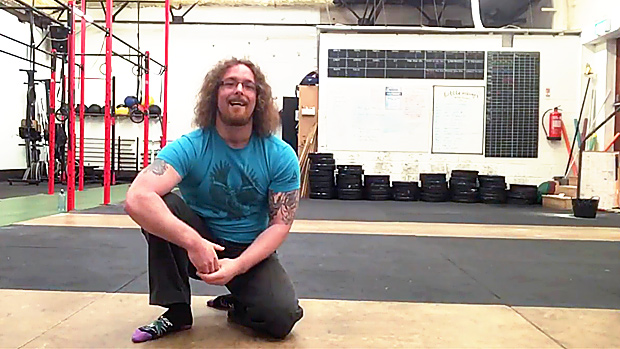You know what a donkey calf raise is, right? It's where you position your feet on a step, bend over (so you look like the guy bringing up the rear of a donkey costume), and then work your gastrocnemius by raising and lowering your body with your toes.
Well, back in the 1980s and 1990s, serious bodybuilders took the donkey idea a step further by having one or two men, the beefier the better, straddle them to add more resistance to the movement.
Turning yourself into a human burro sure looked stupid and I can't even guess how much psychic damage you'd incur by having your erector spinae teabagged by one or two big, sweaty guys. Anyhow, the thinking behind using such a big load was that the gastrocs are comprised mostly of fast-twitch muscle and, as such, need exercises like the donkey calf raise that often use heavy resistance and fewer reps.
The other muscle in the calf dyad, the soleus, is a postural muscle comprised almost exclusively of slow-twitch muscles that are normally reluctant to grow, even if you trained them according to their fiber type, i.e., with light weight and lots of reps.
So a lot of lifters ignored the soleus, devoting most of their efforts to the more compliant gastrocnemius, and if they did train the soleus, they typically used higher reps and lower weights.
It turns out that all of that calf training theory, as well as one of the most fundamental beliefs about muscle hypertrophy in general, might be totally wrong.
You can blame exercise scientists and occasional T Nation contributors Brad Schoenfeld and Bret Contreras and their colleagues for the little bit of acid backing up into your esophagus right about now.
What Brad and his pals found, through an elegant experiment, was that when it comes to calf training, weight doesn't matter. Light or heavy, the gastrocs and the soleus respond equally well.
More importantly, their discovery cast doubt on the belief that muscles should be trained based on their fiber composition, that it doesn't matter if you use heavy weights and low reps on Type I, fast-twitch muscles and lighter weights and higher reps on Type II, slow-twitch muscles.
What They Did
The scientists recruited 30 untrained male students (but four eventually dropped out) to train their calves twice a week on non-consecutive days for eight weeks. They used both the seated calf raise and the standing calf raise, but here's the rub:
The students had their calves "randomized." In other words, they trained one calf exclusively with light loads (20-30 reps max) and the other exclusively with heavy loads (6 to 10 reps).
The test subjects' muscle thickness and maximal strength was assessed immediately before and after the eight-week study.
What They Found
There were four primary findings:
- Muscular adaptations were similar for both the soleus and the gastrocnemius regardless of the resistance used.
- Each of the calf muscles showed "robust hypertrophy," with the lower gastrocnemius showing greater improvement compared with the medial gastrocnemius and the soleus.
- Both heavy and light resistance elicited similar growth in the two-headed gastrocnemius and the soleus.
- Isometric strength increases were similar in both loading conditions (light and heavy resistance).
Here's how the scientists synopsized those discoveries:
"Our findings cast doubt on the claim that training muscles based on their fiber composition provides an additional benefit for enhancing muscle strength or hypertrophy. The results also indicate that the triceps surae muscles respond robustly to regimented exercise, and the associated adaptations are independent of load used in the training program provided that sets are performed with a high level of effort.
"...we present further evidence that light resistance training is a viable strategy to enhance isometric muscle strength and muscle size, as increases in both outcomes were similar between light and heavy resistance training."
What This Means to You
Before these findings change the way we train, we have to at least consider the limitations of the study. For one thing, all the test subjects were newbies. Secondly, they were all men, which might mean that the results wouldn't apply to women.
Thirdly, no biopsies were performed, which means that there might have been individual fiber-type differences between the subjects (even though most biopsies of the soleus in past studies have almost universally shown that the soleus is primarily slow-twitch and the gastrocnemius is primarily fast-twitch).
Next, the study only lasted eight weeks. Who knows if the results would have continued in the same vein after several months?
Lastly, several studies have shown the existence of a "cross education" effect between limbs, meaning that the results you get by training one limb enervate the corresponding muscle of the opposite limb. Of course, all the studies supporting the cross education effect have involved an injured or untrained contralateral limb and not limbs trained concurrently.
The researchers were well aware of these supposed limitations, but regardless, they concluded the following:
"Our findings cast doubt on the claim that training muscles based on their fiber composition provides an additional benefit for enhancing muscle strength or hypertrophy."
The good news is that this study reinforces the practice of undulating periodization, which is a type of training style that's characterized by working muscles in a variety of rep ranges, regardless of presumed muscle fiber composition.
For example, you might do bench press for sets of 6 to 8 reps on one chest-training day and sets of 8 to 12 on the next chest-training day, followed by sets of 12 to 20 or even more on the next before revisiting sets of 6 to 8 again.
Source
- Brad Schoenfeld, Bret Contreras, et al., "Do the anatomical and physiological properties of muscle determine its adaptive response to different loading protocols?" Physiology Reports, 27 April 2020.




